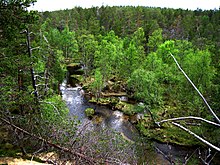Wilderness area
A wilderness area is a region where the land is in a natural state; where impacts from human activities are minimal—that is, as a wilderness. It might also be called a wild or natural area. Especially in wealthier, industrialized nations, it has a specific legal meaning as well: as land where development is prohibited by law. Many nations have designated wilderness areas, including Australia, Canada, New Zealand, South Africa and the United States.
The World Conservation Union (IUCN) classifies wilderness at two levels, Ia (Strict Nature Reserves) and Ib (Wilderness areas).
Most scientists and conservationists agree that no place on earth is completely untouched by humanity, either due to past occupation by indigenous people, or through global processes such as climate change or pollution. Activities on the margins of specific wilderness areas, such as fire suppression and the interruption of animal migration, also affect the interior of wildernesses.
Wilderness areas by country[]
Finland[]
There are twelve wilderness areas in the Sami native region in northern Finnish Lapland. They are intended both to preserve the wilderness character of the areas and further the traditional livelihood of the Sami people. This means e.g. that reindeer husbandry, hunting and taking wood for use in the household is permitted. As population is very sparse, this is generally no big threat to the nature. Large scale reindeer husbandry has influence on the ecosystem, but no change is introduced by the act on wilderness areas. The World Commission on Protected Areas (WCPA) classifies the areas as "VI Protected area with sustainable use of natural resources".
France[]
Since 1861, the French Waters and Forests Military Agency (Administration des Eaux et Forêts) has protected the "artistic reserve" in Fontainebleau State Forest. With a total of 1,097 hectares (2,710 acres), it is known to be the world's first nature reserve.
In the 1950s,[1] Integral Biological Reserves (Réserves Biologiques Intégrales, RBI) were dedicated to interference-free ecosystem evolution, the opposite of Managed Biological reserves (Réserves Biologiques Dirigées, RBD), where a specific management is applied to conserve vulnerable species or threatened habitats.
Integral Biological Reserves exist in French State Forests or City Forests and are therefore managed nowadays by the National Forests Office. In such reserves, all harvests and logging are forbidden, excepting exotic species elimination, or work to avoid fallen tree risk to visitors along already existing tracks in or on the edge of the reserve.
At the end of 2014,[2] there were 60 Integral Biological Reserves in French State Forests for a total area of 111,082 hectares (274,490 acres), and 10 in City Forests for a total of 2,835 hectares (7,010 acres).
New Zealand[]
There are seven wilderness areas in New Zealand as defined by the National Parks Act 1980, the Reserves Act 1977, the Te Urewera Act 2014, and the Conservation Act 1987 that fall well within the IUCN definition. Wilderness areas cannot have any human intervention and can only have indigenous species re-introduced into the area if it is compatible with conservation management strategies.[3]
United States[]
In the United States, a Wilderness Area is an area of federal land set aside by an act of Congress. Human activities in wilderness areas are restricted to scientific study and non-mechanized recreation; horses are permitted but motorized vehicles and equipment are not.
Western Australia[]
In Western Australia,[4] a Wilderness Area is an area that has a wilderness quality rating of 12 or greater and meets a minimum size threshold of 8,000 hectares in temperate areas or 20,000 hectares in arid and tropical areas. A wilderness area is gazetted under section 62(1)(a) of the Conservation and Land Management Act 1984 by the Minister on any land that is vested in the Conservation Commission of Western Australia.
International[]
The IUCN has published their view on wilderness protection, governance and management, Wilderness Protected Areas: Management Guidelines for IUCN Category 1b Protected Areas.[5]
See also[]
- Land use
- National Outdoor Leadership School (NOLS) — A U.S.-based wilderness education program
- List of U.S. Wilderness Areas
- Wilderness Act
References[]
- ^ 1995 & 1998 National Forests Office internal instructions in application of the last paragraph of article L. 212-2 of the French Forest Act
- ^ "L'ONF". Office national des forêts. 2018-10-30. Retrieved 2021-09-13.
- ^ "Department of Conservation: New Zealand Wilderness areas" (PDF). www.doc.govt.nz.
- ^ Department of Conservation and Land Management Policy Statement No 62, Identification and management of Wilderness and surrounding areas.
- ^ Casson, Sarah A.; Martin, Vance; Watson, Alan (June 27, 2016). "Wilderness protected areas" – via portals.iucn.org.
External links[]
- Wilderness Information Network
- The WILD Foundation - dedicated to protecting wilderness internationally
- Wilderness areas
- Protected areas

